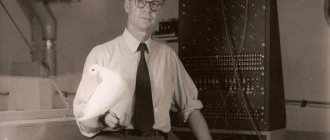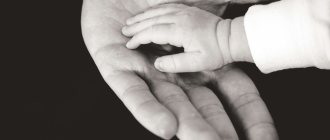Many modern treatments, such as behavioral or exposure therapy, are based in part on behaviorist methods. Behavior therapy uses positive and negative consequences (such as praise or loss of privileges) to change a child's behavior.
This approach has been shown to be effective for developmental disorders such as attention deficit hyperactivity disorder (ADHD).
Do you want to know more about this topic? Then read the best books about behaviorism:
- “Behavior of Organisms”, B. Skinner
- “The power of habit. Why we live and work this way and not otherwise”, C. Duhigg
- “Don't growl at the dog! A book about training people, animals and yourself" K. Pryor
- “In the beginning there was a dog. Twenty years of experiments”, Ivan Pavlov
Study of fear formation
John Watson dealt with the issue of the emergence of fears and phobias and their nature. In the process of studying, an idea came to his mind: is it possible to form fear of an object that has not previously caused it? So he decided on his ill-fated experience, which cost him his career.
The story of 9-month-old baby Albert began in 1920. According to some sources, the test subject was a child from an orphanage, and according to others, he was the son of Watson’s assistant Rosalie Rayner. The name Albert was assigned to the child by the experimenters. What his real name was, history is silent.
The object to which it was decided to induce fear was an ordinary white laboratory rat. For two months in Watson's laboratory, which was an office with two comfortable chairs and a table, the baby was shown various objects. Among them were: a white rat, a rabbit, cotton wool, a Santa Claus mask with a false beard, and other similar objects distinguished by white fur.
Two months later the experiment itself began. The child was seated on the carpet in the office and given a white rat in his hands. The baby was not afraid at all and played with the animal with pleasure. Watson then began his impact. He hit a metal plate (pipe) that was behind the baby with a hammer every time Albert touched the rat. Naturally, the child was frightened by such a sharp and unpleasant sound and began to cry. The baby soon learned the connection between touching the rat and the sound. He stopped touching the animal.
Watson and Rayner described it this way: “The moment the rat was shown, the child began to cry. Almost immediately he turned sharply to the left, fell on his left side, got up on all fours and crawled away so quickly that he was caught with difficulty at the edge of the table.”
Then Watson decided to go even further in his research. Now he placed the rat in the baby's crib and hit the plate with a hammer five times in a row. After this experience, the child began to cry at the mere sight of a white rat. Moreover, he began to be afraid of similar things that were shown to him at the very beginning: white rabbits, cotton wool, Santa's mask and generally white fur. Since there were no hammer blows when they were shown, Watson concluded that the reaction was transferred to all similar objects. This phenomenon is called behavioral transfer. In other words, the effect generalized. A week later, Watson repeated the experiment, and the reaction remained the same, including transfer to similar objects.
Indications
Behavioral psychotherapy does not treat all mental disorders, but only those that are based on a clear and persistent violation of acquired skills and incorrectly developed methods of action. Indications for contacting such a specialist:
- panic attacks;
- phobias;
- obsessive-compulsive disorder;
- depression, dysthymia, bipolar affective disorder, cyclothymia, manic syndrome;
- eating disorders: bulimia, anorexia, psychogenic overeating, allotriophagia;
- sexual psychogenic problems based on psychopathy, endogenous psychoses and character accentuations;
- schizophrenia;
- antisocial, deviant behavior;
- insomnia, nightmares;
- hyperactivity;
- autism;
- poor performance at school, speech therapy problems in children.
As practice shows, therapy is effective in the treatment of many physiological diseases: hypertension, migraine, bronchial asthma, stomach problems.
OUR PEOPLE
Yahoda, Maria Psychologists
British social psychologist of Austrian origin
Jastrow, Joseph Psychologists
American psychologist
Yaroshevsky, Mikhail Grigorievich Psychologists
Soviet and Russian psychologist, historian of science, specialist in the history of science, psycholinguistics, theory and methodology of psychology, psychology of creativity
Justin, Eva Psychologists
German psychologist and famous racial anthropologist of Nazi Germany, is one of the main initiators of the Roma genocide in Germany
Jung, Carl Gustav Psychologists
analytical psychology
Etkind, Alexander Markovich Psychologists
Soviet psychologist, later British and American cultural historian, cultural historian and literary critic
Erikson, Eric Homburger Psychologists
Homburger Erikson was a developmental psychologist and psychoanalyst.
Angell, James Psychologists
American psychologist and teacher, student of John Dewey, one of the leaders of the American branch of functional psychology
Treatment
Despite the variety of methods, treatment in behavioral psychotherapy is carried out primarily according to one scheme:
Behavioral therapy is often used for children who are struggling in school. For example, the shaping method for speech therapy correction, when the main task is divided into a small chain of correct behavioral acts:
Repeat the syllable after the teacher → Read it correctly yourself → Read the whole word correctly → Read an unfamiliar word correctly → Read the whole phrase correctly
At each stage, a method of systematic desensitization is used.
Behavioral therapy is incredibly effective for autistic people. She breaks down all the skills that are difficult for them into separate blocks: speech, contact, play, listening and looking into the eyes. Each of these actions is mastered gradually.
An example of one of the very first exercises in behavioral psychotherapy for autism, “Language - Understanding”:
- Assignment: Raise your hand when asked.
- Hint: the specialist himself takes the child by the hand and raises it, pronouncing the task.
- Stimulus: encouragement in the form of praise or sweets.
- Independent completion of the task.
Autistic children perform this exercise only 5 or even 10 times.
Criticism of the experiment and the fate of “Albert”
The experiment allowed Watson to conclude that reactions of fear, anxiety, phobia and antipathy are formed in people in childhood. But he was unable to rid the baby of his unaccountable fear of white rats, rabbits and objects with white fur. What was the fate of little Albert next? According to some sources, he was adopted, according to others, he left with his mother, but Watson’s experiment, despite the benefits of his discovery for psychology, was severely criticized.
Despite the fact that the experiment with little Albert is famous in psychology and is included in all classical textbooks, it was criticized for two reasons:
- Unethical. In our time, such an experiment could not be repeated.
- Subjectivity. The experiment was carried out with process violations, in the absence of a clear plan. In many ways, the researchers relied on their own interpretations; in addition, the fate of the experimental subject was not followed up further. It was also known that Watson interfered with the experiment, preventing the baby from using any protective behavior, and also contributed to the formation of fear. For example, if a child began to suck his thumb, Watson would remove the finger from his mouth.
The fate of baby Albert remained a mystery for a long time. They said that he grew up to be a strange man, afraid of white fluffy objects all his life. Only recently was it possible to learn more about him. A group of American psychologists led by Hall P. Beck spent 7 years researching this experiment. By studying the geography of the experiment and information about the identity of the boy’s mother, they were able to find out the child’s real name – Douglas Merritt. He died at the age of 6 on May 10, 1925 from hydrocephalus. According to the author of the study, it lasted longer than the life of the child himself. In 2012, Hall P. Back and Alan J. Fridlund made a stunning announcement. It turns out that baby Albert was not at all a healthy, normal child, as Watson stated in his description of his research in 1920. They provided compelling evidence that Watson knew about the baby's illness and deliberately hid this fact. Unfortunately, this new information not only casts doubt on the reliability of the experiment, which is included in all classic psychology textbooks, but also makes it even more unethical and cruel.
A logical question arises: but why?! Why was it necessary for a respected, successful person, who had achieved a lot by the age of 40, to commit such a stupid act - falsifying the initial data of an experiment, unethical experiment... Has he lost criticality to his actions, driven by a passion for science, or is another kind of passion involved - for assistant Rosalie, who may have influenced Watson and his aspirations? Alas, we are unlikely to ever know.
Editor: Chekardina Elizaveta Yurievna
List of used literature:
- Furman University website. Section dedicated to the life and work of John Watson -
- Watson J. “Psychology from a behaviorist’s point of view,” Reader on the History of Psychology. Ed. Galperina P. Ya., Zhdan A. N. M.: Moscow State University Publishing House, 1980. P. 17-18.
- Watson J. “Psychology as the science of behavior.” - M., "AST-LTD", 1998
- Fridlund, A. J., Beck, H. P., Goldie, W. D., & Irons, G. (2012). Little Albert: A neurologically impaired child. History of Psychology. doi: 10.1037/a0026720
- “Conditioned Emotional Reactions,” by John Watson and Rosalie Rayner, The Journal of Experimental Psychology, February 1920
- To write or not to write? - that is the question https://psychosearch.ru/7reasonstowrite
- How to become a partner of PsychoPoisk magazine? https://psychosearch.ru/onas
- Several ways to support PsychoSearch https://psychosearch.ru/donate
Methods
Imitative (observational, vicarious) learning through observation (modeled)
Basis: A. Bandura's theory of social learning.
Essence: The patient is taught a new skill through the process of imitating another person (a psychotherapist, a movie or book character).
Example: Diagnosis - Aichmophobia. During the sessions, the specialist gradually accustoms the person to the idea that nothing bad will happen to him if he uses a needle, knife, fork, razor, or nails in everyday life, demonstrating his skillful use of them.
Basic techniques: self-modeling (replaying successful moments in the patient’s behavior), prompting (encouragement), fading (reducing rewards as the desired form of behavior is consolidated).
Role-playing training (role play)
Basis: imagotherapy, play therapy.
Essence: Playing out a problematic situation for the patient. Moreover, he can play himself, or a psychotherapist can take on his role so that he can see how his behavior looks from the outside.
Example: Diagnosis - alcohol addiction. A romantic dinner situation is being played out. First, the therapist demonstrates the incorrect (true) behavior of his client, how he gets drunk and ruins the date. Then it shows the successful outcome of the event - if you abstain from alcohol. The patient himself participates in the third act.
Basic techniques: group training, confrontation, systematic desensitization.
Biofeedback (BFB procedure)
Basis: theories of conditioned reflexes of Sechenov and Pavlov, cortico-visceral connections of Bykov, functional systems of Anokhin, stable pathological conditions of Bekhterev.
Essence: Equipment is connected to the patient, with the help of which his physical condition is monitored. Along the way, a session is carried out with exercises and tasks. For every successful decision there is a “reward” in the form of relaxing and pleasant sensations that are created by the same equipment.
Example: Diagnosis - depression. The devices record high blood pressure, rapid heartbeat, heavy breathing, hand tremors and other reactions from the autonomic system. The psychotherapist gives the patient the task of relaxation and peace, liberation from heavy, obsessive thoughts. As soon as he succeeds, he hears pleasant music, sees a beautiful clip on the computer monitor, and is treated to something tasty.
Basic technique: physiological mirror.
These are the main treatment methods used in behavioral psychotherapy. Other techniques may also be used:
- aversive therapy (weaning off addictions);
- systematic desensitization (reducing sensitivity to what causes anxiety and phobias);
- implosion therapy (reintegration of suppressed emotions through immersion in traumatic memories);
- shaping (a multi-step process, practicing a new skill through positive and negative reinforcements);
- method of auto-instructions / self-instruction training (use of inner speech to regulate behavior);
- stress vaccination therapy / stress vaccination / stress vaccination training (learning self-control techniques to help cope with traumatic and stressful situations);
- applied behavior analysis;
- “thought stopping” method.
Treatment methods are selected depending on the diagnosis.
Biography
John Brodes Watson was born on January 9, 1878. Emma and Pikens Watson, John's parents, lived in South Carolina, in the small town of Travelers Rest. The mother was very religious, so the boy’s life was full of restrictions and prohibitions. Pikens himself preferred a rather wild life; scandals on this basis led to his father leaving the family in 1891, when the boy was 13 years old. John was attached to his father, so he took the separation hard and could not forgive him for this until the end of his life.
John Watson grew up in Greenville, South Carolina, and received his master's degree from Furman University. On the advice of one of his teachers, he then entered the University of Chicago with the goal of studying philosophy under the guidance of John Dewey. However, in his own words, he did not understand what Dewey was talking about, and soon chose to change his supervisor, turning to psychologist James Angell and physiologist Henry Donaldson. He was going to work with Jacques Loeb on research into the brains of dogs. The combined influence of these scientists then led him to develop a rigorous, objective approach to the study of behavior.
His doctoral dissertation, defended at the University of Chicago in 1903 ("Animal Learning: An Experimental Study of the Physical Development of the White Rat Associated with the Growth of the Nervous System") was the first modern book on rat behavior.
On February 24, 1913, John Watson gave his famous lecture (manifesto) in New York - “Psychology from the Point of View of a Behaviorist.” Since the time of behaviorism, psychology has begun to develop rapidly as an experimental science. Watson generally denied consciousness as a subject of scientific research, reducing mental phenomena to various forms of behavior, understood as a set of reactions of the body to stimuli from the external environment. The purpose of psychological study is to predict what a response will be and to determine the nature of the stimulus involved. The possibilities for reaction are very wide. Watson identifies 4 large classes of reactions:
- visible (explicit) - unlocking the door, playing the violin.
- hidden (habitual reactions (implicit)) - thinking that we consider internal conversation.
- visible hereditary reactions - instinctive and emotional reactions (sneezing, etc.)
- hidden hereditary reactions - internal secretion system (physiology).
From the point of view of behaviorism, psychology is a purely objective branch of natural science. Its goal is to predict behavior and control it.
The influence of behaviorism grew so rapidly that Watson was elected president of the American Psychological Association in 1915.
In 1920, Watson was forced to leave his position at Johns Hopkins University due to the scandal associated with his divorce and affair with graduate student Rosalie Rayner (co-author of a work on conditioning emotions in an 11-month-old boy, which went down in the history of psychology as the “little Albert” case). . He later married Rainer. Not a single university agrees to hire him. He moved to New York, where he took a job in the advertising industry with J. Walter Thompson while lecturing at the New School for Social Research.
Behavioral psychology - books
We offer you a list of 4 books that reveal the phenomenon of human behavior.
1. “Coping behavior. Current state and prospects” – a team of authors.
The book is addressed to a wide range of specialists interested in the adaptive capabilities of a person faced with difficult life situations.
2. “How to find the key to solving any situation. 30 rules for effective communication, conflict resolution, behavior management” - Larisa Bolshakova.
This book contains thirty new psychological techniques. How to avoid a conflict situation and find a compromise? How to find a key to any person? What to do to overcome aggression? And much more!
3. “Organizational behavior” – Lyudmila Zgonnik.
The book examines the essence of organizational behavior, various aspects of managing the behavior of individuals and groups in an organization.
4. “The power of habit. Why we live and work this way and not otherwise” - Charles Duhig.
Duhigg's observations and discoveries largely complement and develop the ideas of Nobel Prize laureate in economics Daniel Kahneman, author of the best-selling book “Thinking Slow... Decide Fast.”
The book is recommended for reading to everyone who is working on themselves and wants to change their life!
WATSON JOHN BRODES
1878-1958) - American psychologist, founder of behaviorism (the science of behavior). His work “Education of Animals” (1903) considers the laws of acquisition of experience by animals and humans as the same, and experience itself as a biological adaptation, devoid of meaning and content. Criticizing such positions of teaching as the denial of consciousness and its role in the formation skills and behavioral acts in humans, identifying the principles of life of humans and animals, at the same time, it should be noted the most important role of U in the experimental substantiation of many behavioral acts of animals, in the organization of special methods of zoopsychology in the study of the formation of animal skills in the conditions of a problem box, labyrinths, etc. methods for studying mental activity
Rate the definition:
—
Perspectives on behavioral psychology
The behavioral approach in psychology assumes that all people have the same potential, and only differences in the environment contribute to the development of unique personality traits.
Although the idea that “we are the result of conditioning” seems rather pessimistic, for behaviorists this position offers promising educational and therapeutic prospects.
If a person depends solely on the environment, then by changing this environment, you can radically influence his life. Changes in the environment would make it possible to change human behavior and even prevent the formation of bad habits or the development of mental illness.
Student scandal: unpopular version of Watson's resignation
Few people know that the official reason for Watson’s resignation was not the infamous experiment, but a public scandal that erupted due to an affair with his research assistant, Rosalie Rayner, who participated in that very experiment. This scandal resulted in his divorce from his wife, Mary Ickes. She somehow managed to intercept her husband’s correspondence with his mistress, after which the angry Mary published it in the local newspaper. The story received wide publicity and affected many of the Hopkins University administration, so Watson was asked to leave his post of his own free will. Which he did, subsequently marrying Rosalie.
Watson was upset by his forced retirement from academic psychology, but then went into another field: he went into advertising, studying the reasons that motivate people to buy. He also spoke on the radio and published his articles in women's magazines, actively promoting the ideas of behavioral psychology. Together with his wife Rosalie, he lived on a farm, was fond of horse riding, and loved to boat. However, at the age of 35, Rosalie died from a sudden illness. It was a hard blow for Watson. After burying his wife, he moved to a small farm in Woodberry, Connecticut, where he lived until his death in 1958.
Contraindications
Behavioral psychotherapy is contraindicated in some cases. This applies to those patients who have a persistent impairment of consciousness if they cannot understand what is required of them. This entails the inability to perform exercises and tasks aimed at treatment.
Absolute contraindications:
- worsened psychoses;
- prolonged depression in severe form;
- deep UO.
Relative contraindications:
- personality disorders - a course of treatment will be effective only if the psychotherapist manages to establish trusting contact with the patient;
- mild form of mental retardation - treatment is possible, but only with the selection of simple tasks and exercises that the patient can cope with.
Each specific case of contacting a psychotherapist is considered individually.
Reviews of events in this area collapse ↑
Victoria Degtyareva (guest) wrote on March 26, 2022 Course “Oratory skills.
The art of public speaking,” trainer: Anastasia Goncharova Nastya, thank you for such a great course on public speaking, I am sure that all the skills and techniques that you taught us will be useful not only for public speaking, but also in everyday life. Thanks to these courses and you personally, it has become easier for me to communicate with people. In general, I gained a lot of knowledge... Read more
36 more
| Moscow, Krasnodar, Volgograd, St. Petersburg, Kazan, Magnitogorsk, Yekaterinburg, Almaty, Krasnoyarsk, Irkutsk, Vladivostok. |
Thank you for your interest in the topic “what is Behavioral Psychotherapy”!
Sources used:
- https://mentalsky.ru/povedencheskaya-psihologiya/
- https://ponervam.ru/povedencheskaya-terapiya.html
- https://psychology.academic.ru/1681/behavioral_approach
- https://samopoznanie.ru/schools/povedencheskaya_psihoterapiya/
Unlearning
A much more stringent method in behavioral therapy, which is based on the explicit avoidance of one or another factor that should be gotten rid of. Using the same system of rewards for positive actions and a system of punishments and fines for negative ones, a person gradually begins to lose the habit of doing what he should not do. The most interesting thing is that the unlearning technique can be effective not only on the mental or psychological level, but also on the physical. A clear example from the first area is alcoholism. When a person begins to drink alcohol, the process should be accompanied by an extremely unpleasant odor that causes vomiting. Gradually, alcohol will begin to be associated with just such negative feelings. An example from physiology is enuresis. A special device is attached to the patient, which reacts to the appearance of urine. At the same moment, the patient awakens and realizes that he is urinating.
Regular classes1
Goals, fears and desires. Training course3 hoursKievWebinar “Working with a patient with a personality disorder using cognitive-behavioral psychotherapy techniques”...3 daysProgram “Working with a patient with a psychosomatic illness using cognitive-behavioral techniques...3 daysProgram “Cognitive-behavioral therapy techniques in family counseling”. There is a possibility of participation...3 days
| Cognitive-behavioral psychotherapy in working with a patient with a personality disorder and psychosomatic...4 months, 144 academic days. hours |
Behavioral psychotherapy
: subscribe to news from this area. Events in other regions 8
McGregor's works
The first scientist who managed to introduce behaviorism into the field of management was Douglas McGregor. According to his interpretation, the behavioral approach to leadership is nothing more than a careful study of the habits and actions of a particular “boss” and imitation of them. There are certain specific features in the behavior of each leader that unite this category of people:
- High intelligence.
- Self confidence.
- Certain socioeconomic status.
- Responsibility.
- Communication skills.
- Objectivity.
In all other respects, the qualities of a leader are determined by the organization or group of people that he “possesses.” An equally important factor is the environment - for example, the leader of an agricultural community will know a lot about agriculture, but at the same time will not be able to remember any of the presidents of America, and the leader of a financial organization will be well versed in the economic sphere, in the sociological sphere, in banking, and even in legal, but is unlikely to be able to competently grow watermelon or potatoes. That is, each pot has its own top.
Direction use
| Organizers |
Types of leaders
In the behavioral approach to leadership, McGregor identified two theories - X and Y. They are like two types of leader, and each of the theories is applicable in all spheres of activity: both agricultural and economic.
- Theory X - authoritarianism and despotism. The implication is that people initially do not want to work and are shirking in every possible way. They do not need acts of ambition, but crave security. For such people to work, strict control and a system of punishments and threats are necessary.
- Theory Y - democracy and integration. Labor is the basis of every person’s life, in it he realizes himself. Under favorable conditions, each employee will be able to take on part of the responsibility and independently strive for success. Introducing people to simple and understandable rules and common goals allows each of them to control themselves. As a result, the leader only combines all the achievements of the employees and corrects the blots. The team works holistically, and the result exceeds all expectations.
Elimination
A very effective method that has become widely known as systematic desensitization. Its essence is that fear or phobia is suppressed by a state of relaxation. Let's say a person is very afraid of heights and, being on the roof of a skyscraper, begins to experience not only conscious anxiety. His body begins to react to fear: muscles contract, pulse quickens, blood pressure rises. So the body and consciousness unite in a state of horror, and the person finds himself completely paralyzed in front of his phobia. If you break this connection, the fear will dry up, and this can be done either by teaching your consciousness not to notice the height (which is almost unrealistic, because it decided to be afraid of this phenomenon), or by relaxing physically. The second option is simpler to implement. Therefore, a person is deliberately placed in the environment where he feels the greatest anxiety, and at the same time, with the help of medications or certain psychological manipulations, his muscular corset is relaxed and his cardiac indicators are reduced. Gradually the fear completely disappears.
Which theory is truer?
There is no and cannot be a correct answer to this question. Both theories are equally correct, and the correctness of one or the other depends on the mentality of people, their abilities and skills, experience and type of activity. In fact, there are still organizations that practice authoritarian leadership systems. Many employees are really simply not accustomed to order and self-control; they refuse to work in every possible way, so for such mistakes they need to be fined and subject to penalties. As a rule, people with a low level of intelligence behave this way, and this phenomenon occurs mostly in underdeveloped countries. A more progressive society most often works according to scheme Y - that is, the boss is part of the team, a connecting link, and not a Cerberus. Each of the employees understands perfectly well that the success of the company will in any case affect his success, so he is not lazy, but works and makes every effort to do this, using creativity and practical skills.
Directions
Behavioral psychotherapy is evolving and has several branches.
Dialectical-behavioral psychotherapy
In 1987, the American psychologist M. Linehan gave birth to a new direction, which was called dialectical behavioral psychotherapy.
The goal is to treat borderline personality disorders.
Results:
- the risk of an emotional reaction to traumatic situations is reduced;
- the risk of suicide, aggression, and deviant behavior is reduced.
Dialectical psychotherapy received this name because the patient begins to realize that even the most hopeless situation has several ways of successful resolution. During the course of treatment, he learns to be calm, weigh the pros and cons, and choose the best outcome.
This is the eclectic movement of the “third wave”. Methods used: problem analysis, involvement in action, effective communication, non-judgment, meditative techniques, self-soothing, etc.
Rational Emotive Behavioral Therapy
In 1955, American cognitive therapist A. Ellis developed rational emotive behavioral therapy (REBT for short). It is based on the “ABC” model (other names: model of the development of emotional disorders, model of therapeutic change, ABC theory of personality). Its decoding:
- “A” - activators: current events, thoughts, feelings;
- “B” - views: beliefs, subjective goals, physiological predisposition, attitudes, principles;
- "C" is a consequence.
To change “C”, either “A” (superficial level) or “B” (deep modifications) undergoes correction. This is what a rational emotive behavioral therapy specialist does during the treatment process.
Techniques used:
- “ABC” REBT;
- discussion;
- bibliotherapy;
- unconditional acceptance;
- self-disclosure;
- time projection;
- self-hypnosis;
- role training;
- cognitive homework.
According to statistics, the behavioral direction in psychotherapy achieves treatment success in 90% of even the most advanced cases. The wide range of pathologies considered (from learning difficulties in schoolchildren to severe mental disorders) makes it promising and worthy of additional investment. And this applies primarily to human resources, since today there are very few good specialists working in this field.










